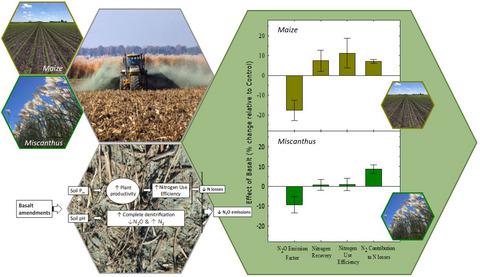当前位置:
X-MOL 学术
›
GCB Bioenergy
›
论文详情
Our official English website, www.x-mol.net, welcomes your
feedback! (Note: you will need to create a separate account there.)
In silico assessment of the potential of basalt amendments to reduce N2O emissions from bioenergy crops
Global Change Biology Bioenergy ( IF 5.9 ) Pub Date : 2020-10-07 , DOI: 10.1111/gcbb.12757 Elena Blanc‐Betes 1, 2, 3 , Ilsa B. Kantola 1, 2, 4 , Nuria Gomez‐Casanovas 1, 2, 3 , Melannie D. Hartman 5 , William J. Parton 5 , Amy L. Lewis 4 , David J. Beerling 4 , Evan H. Delucia 1, 2, 3, 4, 6
Global Change Biology Bioenergy ( IF 5.9 ) Pub Date : 2020-10-07 , DOI: 10.1111/gcbb.12757 Elena Blanc‐Betes 1, 2, 3 , Ilsa B. Kantola 1, 2, 4 , Nuria Gomez‐Casanovas 1, 2, 3 , Melannie D. Hartman 5 , William J. Parton 5 , Amy L. Lewis 4 , David J. Beerling 4 , Evan H. Delucia 1, 2, 3, 4, 6
Affiliation

|
The potential of large‐scale deployment of basalt to reduce N2O emissions from cultivated soils may contribute to climate stabilization beyond the CO2‐removal effect from enhanced weathering. We used 3 years of field observations from maize (Zea mays) and miscanthus (Miscanthus × giganteus) to improve the nitrogen (N) module of the DayCent model and evaluate the potential of basalt amendments to reduce N losses and increase yields from two bioenergy crops. We found 20%–60% improvement in our N2O flux estimates over previous model descriptions. Model results predict that the application of basalt would reduce N2O emissions by 16% in maize and 9% in miscanthus. Lower N2O emissions responded to increases in the N2:N2O ratio of denitrification with basalt‐induced increases in soil pH, with minor contributions from the impact of P additions (a minor component of some basalts) on N immobilization. The larger reduction of N2O emissions in maize than in miscanthus was likely explained by a synergistic effect between soil pH and N content, leading to a higher sensitivity of the N2:N2O ratio to changes in pH in heavily fertilized maize. Basalt amendments led to modest increases in modeled yields and the nitrogen use efficiency (i.e., fertilizer‐N recover in crop production) of maize but did not affect the productivity of miscanthus. However, enhanced soil P availability maintained the long‐term productivity of crops with high nutrient requirements. The alleviation of plant P limitation led to enhanced plant N uptake, thereby contributing to lower microbial N availability and N2O emissions from crops with high nutrient requirements. Our results from the improved model suggest that the large‐scale deployment of basalt, by reducing N2O fluxes of cropping systems, could contribute to the sustainable intensification of agriculture and enhance the climate mitigation potential of bioenergy with carbon capture and storage strategies.
中文翻译:

对玄武岩修正案减少生物能源作物中一氧化二氮排放量的潜力进行计算机评估
玄武岩大规模部署以减少耕作土壤中N 2 O排放的潜力,可能不仅有助于增强气候,还可以起到除CO 2去除作用之外的气候稳定作用。我们使用了3年的玉米(Zea mays)和猕猴桃(Miscanthus × giganteus)的实地观测,以改善DayCent模型的氮(N)模块,并评估了玄武岩改良剂在减少两种生物能源作物中氮素损失和增加产量方面的潜力。 。我们发现N 2 O通量估算值比以前的模型描述提高了20%至60%。模型结果预测,玄武岩的应用会减少N 2玉米中O的排放量为16%,桔梗中的O排放量为9%。较低的N 2 O排放量与玄武岩引起的土壤pH值升高的反硝化过程中N 2:N 2 O比率的增加有关,其中磷的添加(某些玄武岩中的一小部分)对固定氮的影响贡献很小。玉米中N 2 O排放量的减少量比玉米罐中的排放量大,这可能是由于土壤pH值和N含量之间的协同作用所致,从而导致N 2:N 2的敏感性更高高施肥玉米中O与pH值变化的比率。玄武岩改良剂使玉米的模拟产量和氮素利用效率(即作物生产中的肥料氮素回收)适度增加,但并未影响米果的生产力。但是,提高土壤磷的利用率可以保持高养分需求作物的长期生产力。减轻植物P的限制导致植物对N的吸收增加,从而导致较低的微生物N利用率和高养分需求作物的N 2 O排放。改进模型的结果表明,通过减少N 2可以大规模部署玄武岩耕作系统的O通量可通过碳捕获和储存策略促进农业的可持续集约化,并增强生物能源的气候缓解潜力。
更新日期:2020-12-10
中文翻译:

对玄武岩修正案减少生物能源作物中一氧化二氮排放量的潜力进行计算机评估
玄武岩大规模部署以减少耕作土壤中N 2 O排放的潜力,可能不仅有助于增强气候,还可以起到除CO 2去除作用之外的气候稳定作用。我们使用了3年的玉米(Zea mays)和猕猴桃(Miscanthus × giganteus)的实地观测,以改善DayCent模型的氮(N)模块,并评估了玄武岩改良剂在减少两种生物能源作物中氮素损失和增加产量方面的潜力。 。我们发现N 2 O通量估算值比以前的模型描述提高了20%至60%。模型结果预测,玄武岩的应用会减少N 2玉米中O的排放量为16%,桔梗中的O排放量为9%。较低的N 2 O排放量与玄武岩引起的土壤pH值升高的反硝化过程中N 2:N 2 O比率的增加有关,其中磷的添加(某些玄武岩中的一小部分)对固定氮的影响贡献很小。玉米中N 2 O排放量的减少量比玉米罐中的排放量大,这可能是由于土壤pH值和N含量之间的协同作用所致,从而导致N 2:N 2的敏感性更高高施肥玉米中O与pH值变化的比率。玄武岩改良剂使玉米的模拟产量和氮素利用效率(即作物生产中的肥料氮素回收)适度增加,但并未影响米果的生产力。但是,提高土壤磷的利用率可以保持高养分需求作物的长期生产力。减轻植物P的限制导致植物对N的吸收增加,从而导致较低的微生物N利用率和高养分需求作物的N 2 O排放。改进模型的结果表明,通过减少N 2可以大规模部署玄武岩耕作系统的O通量可通过碳捕获和储存策略促进农业的可持续集约化,并增强生物能源的气候缓解潜力。











































 京公网安备 11010802027423号
京公网安备 11010802027423号